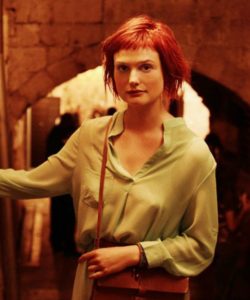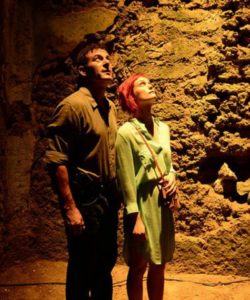Warning: This interview contains spoilers for the April 9 episode of “Dig.”
If USA’s event series “Dig” seems like the perfect blend of political intrigue, character-driven mystery and high-octane adventure, it should. The ambitious 10-episode project comes from “Homeland” producer Gideon Raff and “Heroes” creator Tim Kring, setting forth a complex, multigenre narrative that spans continents and cultures to explore the deep-rooted rituals of Middle East religion and present-day stateside cults.
Actress Alison Sudol portrays young, idealistic archaeologist Emma Wilson, whose apparent murder in the pilot kicks off an investigation into international conspiracy and ancient prophecy that could potentially alter the course of human history. Thursday night’s game-changing twist revealed Emma is actually alive, however, making her role in the series and its complicated framework all the more crucial.
The Workprint spoke with Sudol about her character’s evolution on and off-screen, and how this epiphany will send the remaining four episodes into excavation overdrive.
WP: Early reviews made direct reference to your character being the anchor and, in a lot of ways, the most compelling aspect of the show. You’re the missing link of sorts to connect the three main storylines — between what’s happening in Jerusalem, what’s happening with the compound in New Mexico and what’s happening with the red calf. Now, along with the symbol that was discovered in Emma’s journal in episode five, everything is really starting to come together after a slow burn. I know I was disappointed to see her get killed off, at least deceptively, at the end of the pilot. Although things have been progressing without you, you’ve still been a presence on the show.
All that being said, it’s a major surprise to see Emma resurface for the second half of the series. How is she going to continue serving the same purpose with this revelation happening? From what we saw at the end of episode six, she’s clearly terrified and has been through a lot. She’s lost that effervescent whimsy that she had in the pilot. Are you changing your approach to the character as she moves forward?

Sudol: As a person, you can’t endure something that’s as shocking as what she’s gone through – which we’ll find out more about in coming episodes – and not have it affect you. I think that there’s a pretty serious depth to it that affects her. What would be the way to describe it? Her effervescence, as you said?
WP: Sure. For lack of a better term, she’s kind of the Manic Pixie Dream Girl in the pilot, and she’s not really able to embody that after the trauma we don’t know about yet. Clearly, though, things have shifted for her.
Sudol: Yeah. But at the same time, at her core she’s a fighter. Even from this terrible situation that she’s been in, she’s managed to get herself out. She has a pretty powerful life force. So, a little bit of her whimsy maybe has shifted into something more focused. I guess it’s a bit darker. But there’s still something to her. There’s still that sense of mystery. It’s just evolved. I think that’s a large part of what makes her interesting as a character, and what she brings out in Peter [co-star Jason Isaac] as well.
WP: For the most part, from episodes two through five, Emma’s been a symbol. But now she’s back in the flesh and you said she has a bit more focus. So now that she’s able to be a living person and contribute to the narrative in a more direct way, she’s going to have an even stronger presence on the show in that sense. Were you able to look at her from a different perspective? As an actor, you typically construct your own character history before you enter production, but in this case Emma’s backstory was constructed for you while she was presumed dead.
Sudol: There’s definitely a lot under the surface that I had to delve into in order to give her a realistic and living, breathing portrayal. I mean, it can’t just be flat. But, it’s definitely abstract because I was aware since the beginning that there are things about her that were even obscured from me. I had to leave room for that. What it gave me was a mystery about her for myself that I think gives an interesting feeling to the character. She’s a mystery to me. [laughs]. As people, we don’t always know what happened that makes us act in certain ways. Things happen in childhood that can completely shape the way we think and feel that maybe we don’t even recall anymore. But they are a part of us and they come alive in certain situations, and I think that’s how I approached [Emma] – like there’s a deep, subconscious well underneath her actions that I knew I would be able to see into at some point, and that’s what drove me, to get to that place and to uncover the answers.
WP: What parallels do you see between Emma and Lauren Ambrose’s character [Debbie, the escaped cult member in New Mexico]? They kind of seem to be each other’s antithesis. Emma is this ambitious free spirit. She’s very inquisitive, and she is the digger of the show, literally and figuratively, whereas [Debbie] willfully entered this very oppressive cult and suddenly realizes there’s a life to be lived and she’d been confined to a way of life and a way of thinking she really doesn’t even want to be a part of. These two female characters are really the strongest ones on the show, and their trajectories could really align well with each other despite the different paths they’re on.
Sudol: I think there are parallels between quite a lot of the characters and elements in the show, and that’s something we get a stronger sense of the more we go along. I mean, there are also parallels between colors – red is a very strong color in the show, and there’s certain red elements that correlate with each other. There’s just a lot at this point. We’re pretty much in the middle of the show, and the last episodes are so jam-packed with crazy amounts of information unfolding. I think you’ll see a lot more parallels and also a lot of paths kind of leading to the same point. It’ll make a lot more sense.
WP: It seems like a foundation has been laid, so to speak, in these first few episodes. We’ve been digging, as viewers, into the story and we’ve reached this point where we’ve really discovered something and there’s been an excavation going on. So I’m gathering that the pace might really kick into high gear after this, with the discovery that Emma’s alive?
Sudol: It does. It really does. It’s kind of like going into warp drive. [laughs]
WP: “Dig” is quite the ambitious project. As has been said, it’s a conspiracy 2,000 years in the making, and it’s being touted as a truly multi-layered experience. Was it intimidating to face such a high-concept show, and how did you respond to the material?
Sudol: I think the fact that there is so much depth to the material and that it is as ambitious as it is what was exciting to me. It’s bold, and it’s meant to give you far more questions than it gives you answers – at least for a while. That’s something I find compelling even though, as human beings, we always want to know immediately.
WP: Yes. We’re in an instant gratification kind of culture right now, for sure.
Sudol: Absolutely! We want an answer on Google within seconds, and if we’re not in good service and it takes, like, 45 seconds to get an answer we’re all, “This is ridiculous!” [laughs] We want internet on our airplanes. So, I think the fact that you have to be patient and you have to put things together and you might have to watch episodes more than once to actually get the clues that you need, those are all things that I’ve found to be kind of the opposite – it’s not that they’re not intimidating, but they made me more interested in actually creating this character and being part of the show. Easy things don’t usually set me alight. What could I learn from that?

WP: You actually touched upon something I was going to ask about next. Jason Isaacs has teased about this shocking revelation that’s coming up, and said viewers might want to revisit previous episodes after learning Emma’s fate. Do you think the show would play differently in retrospect after finding out Emma’s alive?
Sudol: Definitely. Because I know and I’ve known for such a long time, it’s interesting. I’ve had a different perspective on it, but I’ve tried to watch the episodes…[pause]
WP: As objectively as you can, anyway.
Sudol: Yeah, while not carrying that information with me as much as possible. I can see how you could miss things if you’re not really aware enough of how much you should be paying attention to the details. I can see how certain things would just fly by. You see a symbol somewhere, but it’s only a flash and you need to pay attention to where that flash was, or, something in Emma’s journal. These are things that her being alive definitely affects what they mean.
WP: Right. So, touching on that, “Dig” comes from the creators of “Heroes” and “Homeland,” and, like “Heroes” especially, begs the same type of viewing experience where, as a viewer, you really want to try and analyze every possible foreshadowing element or potential symbol. Do you think viewers could respond to it in that way where they’re almost, like a show like “Lost” did, creating their own culture, their own tangential, alternate universe of sorts?
Sudol: Certainly. I do think that is that strength in this second half of the season because after Emma comes back, a lot of things start coming together, and that’s when really big questions start coming to the forefront. That’s definitely been happening throughout the whole first half, but now the real discussions and debates will come because the backstory will start connecting with the present story in a clearer way, but there will still be pretty significant chunks there to argue with your friends about. [laughs] That’s kind of the intent of the show, to get people talking. An exciting part of any project is having people want to find out answers on their own. There’s a whole online thing on Dig Decoded that provides all kinds of backstory there and that’s meant for that exact purpose, for people to play detective on their own. This story needs all the help it can get, because it’s complex. The more that the viewer finds out for us, the better the show will unfold.
What will “Dig” uncover next? Find out Thursday nights at 10/9c on USA.
Follow Erin on Twitter: @ErinBiglow
